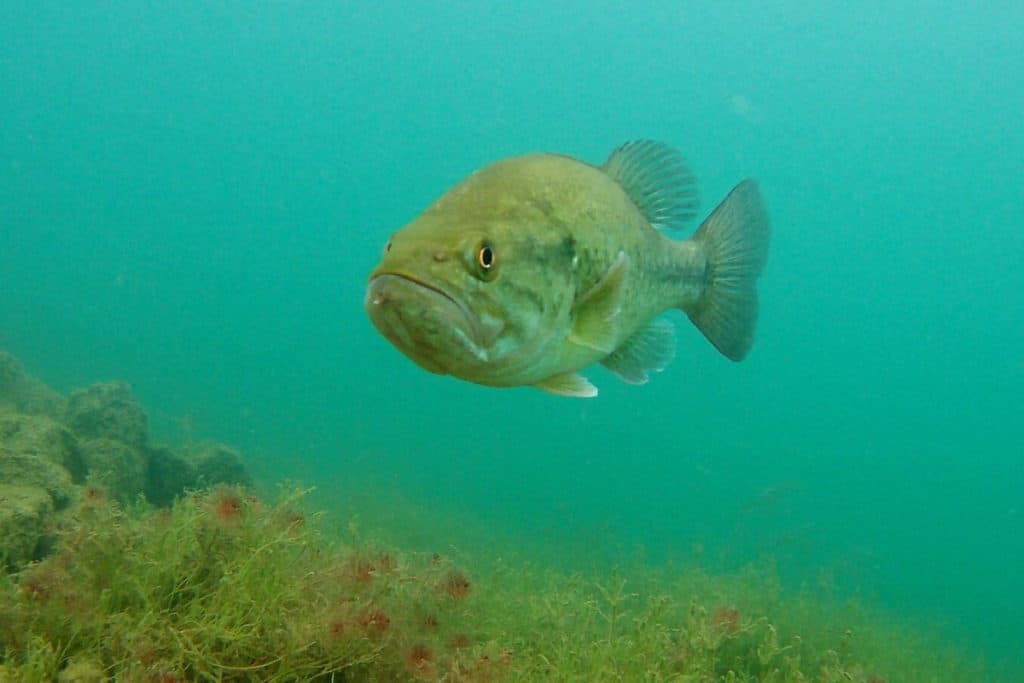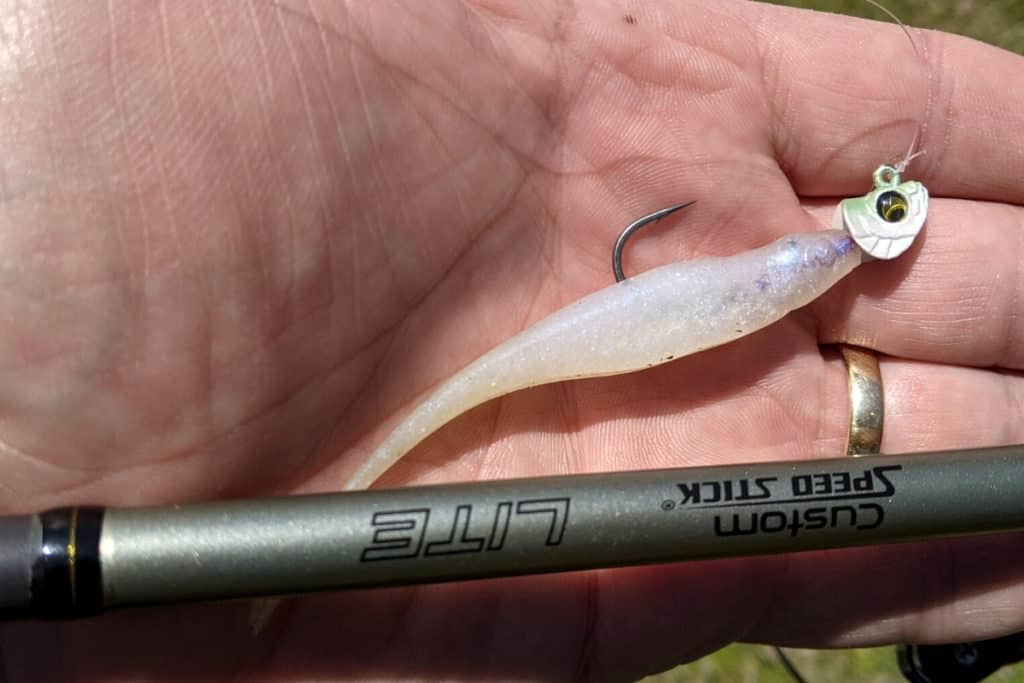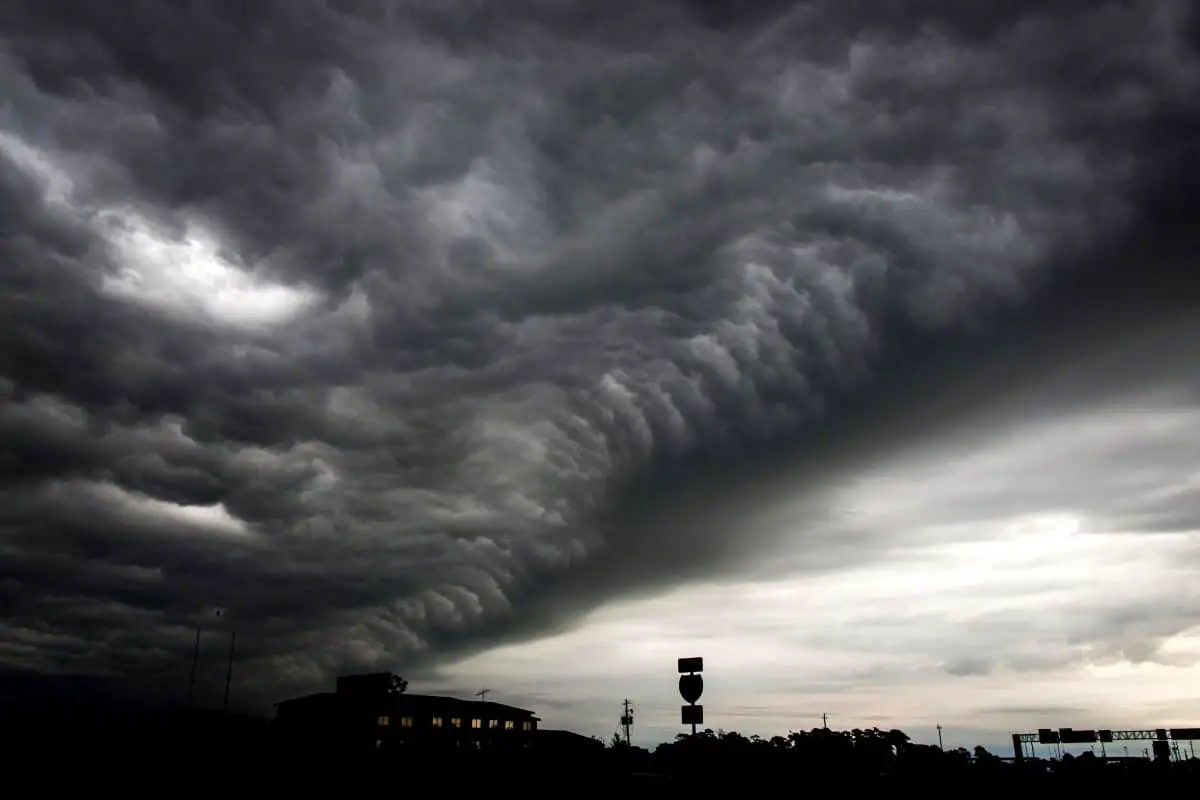Cold front. Two words that anglers hate. After doing some underwater filming during the last cold front that ripped through my area, I have a new approach and confidence when fishing these traditionally tough conditions.
Largemouth bass do not always move far during a cold front. Often the bass will slip to the bottom edge of the cover they were hanging on before the front hit. The strike zone of the bass will diminish and instead of moving around, focus on hitting an area with many casts.
This simple approach to fishing for largemouth after a cold front will help you gain confidence and anticipate going to the lake instead of waiting for warmer days.
Largemouth are Most Affected by Cold Fronts
Largemouth bass tend to relate to shallow cover and structure more often than their smallmouth and spotted bass cousins.
Fish that relate to deeper haunts are less-likely to be as adversely impacted by the sudden weather change a cold front can bring in. Largemouth anglers that live in the southern portions of the country can really see a drastic behavior change.
Fish living in cooler climates will still react to a cold front coming through, but it is not as devastating to an angler’s day as in warmer locales.

What I Discovered Filming Bass Underwater After Cold Fronts
I was shocked by what I learned during this process. Like many bass anglers, I understand that bass will often move deeper after a cold front.
It is obvious. The shallows are often left void of life.
What I didn’t understand is that the largemouth did not move that far. Time-after-time when a cold front hit, I was fishing too deep. My lures were under where the bass were actually sitting. I had no idea, until now.
Two Examples of How Far Largemouth Actually Moved After a Cold Front
I did my underwater filming research in two types of water clarity: ultra-clear and murky.
Murky Water Cold Front Largemouth
Before the cold front, bass in the murky water could be found hanging in water that was about 1 ½ feet in depth. This was a prespawn situation and the bigs were wanting to come up shallow.
After the cold front hit, those bass moved or slipped down to the bottom edge of the cover they were sitting on.
The vegetation was very short where they were scouting out potential nesting sites. When the weather changed, they doubled their depth and I found them sitting in about 3 feet of water, but most importantly, they were relating to the bottom edge of the vegetation – right where the weeds transitioned into the mud bottom.
The largemouth were not moving much. They would circle, slowly, in the same area.
Ultra-Clear Water Cold Front Largemouth
Before the cold front hit, bass in my clear water location were sitting in 3-4 feet and hanging above rip-rap. This rock was at the bottom of a boat ramp and used to deter prop wash from digging a hole in the lake bed.
After the weather change, like the murky water bass, these ultra-clear water fish slipped to the bottom edge of the rip-rap and were now hanging out in 6-8 feet of water.
They too doubled their depth, but the most important factor is where they positioned themselves on the cover they were already using.

Focus Your Search on Where The Bass Were or Usually Are
If you are fishing your home waters, then you are most likely familiar with some areas that tend to hold bass most of the time.
Start in these places and fish slightly deeper. As I mentioned above, look for the bottom edge of the dominant cover or structure the fish were sitting on.
Where do the weeds stop? Where does the rock taper off? Where does one form of cover or structure transition into another?
The fish likely moved deeper, but not as deep as we often think.
If you are fishing a new lake or river, this is the time to hit those “textbook” high percentage places. Focus on points or some type of vertical structure like bluff banks or even something like sea walls.
Pick out a few that you feel good about and believe that there are bass in that area.
Saturate The Area With Presentations and Minimize Running Around the Lake
Our natural instinct as bass anglers is to move when we are not getting bit.
This is the exact opposite of how we want to approach post cold front conditions. It may take ten, fifteen, twenty, or even thirty casts to a small area to coax those fish into biting.
We must be confident that our lures are in high percentage places and patiently watch and wait for the slightest thump.
These are the types of days where you are not fishing for fifty bites, you may be looking for five. It sounds daunting, but if you can pack up and head home knowing you pulled out five bites in some of the toughest conditions bass anglers face, then you can take solace in the fact that you are becoming a great angler.

Lures for Cold Front Bass Fishing
Keeping your lure in the “zone” for as long as possible is the key to success after a cold front.
The bass will have shortened up their strike zone, or how far they are willing to chase. Lures and presentations that can sit and soak are more likely to trick that bass into biting.
Bass anglers tend to fish too fast during optimal conditions – that is definitely true after cold fronts.
Neko Rig for Cold Front Bass
The beauty of this rig is the fact it can sit in one place for a very long time.
The slightest currents in the water will impart action on the lure, and if needed, we can supplement this with a slight hop or drag with our rod.
I prefer to use Elaztech plastics on this rig during post cold front fishing because it is buoyant. The worm will sit upright and that tail will twitch and bounce without me doing anything. The lure can sit, sit, and sit some more.
Traditional plastic worms will fall over. If the bottom cover is silty or has some short vegetation, the entire rig may be obscured from the bass.
Post Cold Front Bass and the Ned Rig
If I am fishing a bottom composition that is very clean and in clear water, the Ned rig is hard to beat.
This extreme finesse style lure possesses an uncanny ability to coax bass into biting.
Like the Neko rig, I am going to use Elaztech plastics to keep the lure more visible to the bass. It is important to remember the strike zone is very small and using a plastic that can sit for extended periods will trigger many more bites.
If the water you are fishing has a silty bottom composition, this is not the best rig to choose. It needs a clean bottom, preferably a hard bottom, to be most effective.
Bass Fishing after a Cold Front With the Damiki Rig
An easy meal is hard for bass to resist – even bass that are lethargic because of a cold front.
Unlike the other two rigs that can sit, I fish this with a very slow swimming retrieve. In deeper water, the rig is very effective fished vertically like you would when ice fishing.
I use lightweight Damiki heads, something in the 1/16 oz or ⅛ oz range.
My favorite lure to use on the rig is the Strike King Baby Z Too. Yes, it is Elaztech and helps the lure to maintain its position in the water column while being presented slowly.
I let the lure sink to the bottom and then reel it back while slightly thumping the side of my spinning rod with my index finger. This imparts an ultra-realistic swimming motion to the lure that can trigger bass to swallow this unwary little creature moving through their personal space.
Final Thoughts
Largemouth bass often do not move far after a cold front pushes through. They will slip deeper, but not as deep as I once thought.
Target the bottom edge of the structure or cover they were sitting on and hit the area again-and-again. This is not the time to be running around the lake and trying a thousand different locations.
Use lures that can be presented slowly and set the hook on anything that feels odd. Most bites will be detected by weight rather than a jarring thump.
Conquering post cold front conditions is something to be proud of. Many, many anglers give up or never head to the lake at all.
Tight lines. Be safe and make sure to encourage someone today. You never know how you may change their life forever.
Isaiah 6:8

